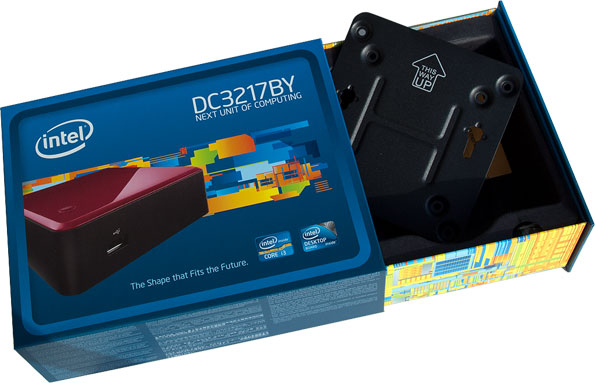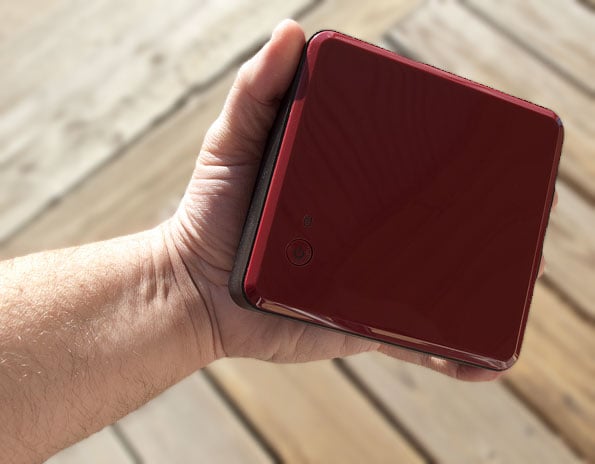Intel's Tiny NUC "Next Unit of Computing" PC
External Design & Layout
Intel plans on launching different versions of its NUC, including one that supports simultaneous monitor and display applications (DC3217IYE). The one we have for evaluation is the DC3217BY. It's equipped with dual PCI-E mini card slots, HDMI output, and a ThunderBolt port that allows you to daisy chain multiple devices.


Interestingly enough, it wasn't the NUC's size that we first noticed during our unboxing. No, it was something far more subtle, yet oddly appealing. We typically don't cover packaging in our reviews (unless it sucks so bad that it warrants coverage) because, quite frankly, it's boring. So why the quick exception in this case? Intel forced our hand by hiding a light-controlled sound module in the retail packaging. When you slide the container out of the box, Intel's familiar jingle plays loud and clear. It seems silly, but it catches you completely by surprise, putting you into an Intel frame of mind. Well played, chipzilla.
Enough of that, moving on...
Enough of that, moving on...
The beauty of Intel's NUC is in its size. It's not quite small enough to shove inside a normal sized pocket like a smartphone or media player, but it does fit snugly in your palm, allowing your fingers to grip the sides. People with larger hands will be able to curve their fingertips up and over the top. If you prefer hard numbers, the NUC measures 4.59 (L) inches by 4.41 (W) inches by 1.55 inches (H) and weighs approximately 1.1 pounds. It's not big, nor is it heavy by any stretch of the imagination. According to Intel, these dimensions comprise "The shape that fits the future," as the tagline on the consumer retail box reads.
It's an interesting piece of hardware that's smaller than most nettops out there, and about half the size of Zotac's ZBOX mini PC line (the Intel Atom-based ZBOX ID80 Plus we reviewed earlier this year is almost twice as big at 7.40 inches by 7.40 inches by 1.73 inches). And about the same size as a ZBOZ nano.
Intel outfitted the NUC with a dash of color. The top of the system sports a maroon cover, including the power button, and the rest of the unit is black. A blue LED HDD activity light lets you know when the mSATA drive is working, and the power button also glows blue when turned on.
Other than for convenience, orientation hardly matters with the NUC since it's practically the same length and depth. Technically there is a front, that being the one closest to the power button, and also the side that houses one of the three USB 2.0 ports. Why no SuperSpeed USB 3.0 ports? That's an excellent question, and unfortunately we don't have a satisfactory answer. The Intel QS77 Express Chipset the NUC is built around supports up to four USB 3.0 ports and up to 10 USB 2.0 ports, and for whatever reason, Intel chose to go with the slower spec. It's a non-issue for some of the intended applications, like digital signage, but for the home consumer -- and particularly home theater buffs who may want to transfer large files over USB -- it's a bit of a bummer.
The lone USB port on the front gives the NUC an understated design aesthetic. Don't mistake that to mean that Intel didn't put much thought into it. For a system this size, cooling is of paramount importance, and to help dissipate heat, Intel wrapped an aluminum belt around the waist of the NUC. The top, as previously mentioned, and the bottom are both made with plastic.
The lone USB port on the front gives the NUC an understated design aesthetic. Don't mistake that to mean that Intel didn't put much thought into it. For a system this size, cooling is of paramount importance, and to help dissipate heat, Intel wrapped an aluminum belt around the waist of the NUC. The top, as previously mentioned, and the bottom are both made with plastic.
Just a handful of ports are jammed into the NUC's rear I/O panel. From left to right, you can see the DC power plug, two USB 2.0 ports (three total, including the one in front), HDMI 1.4a output, ThunderBolt (with support for DisplayPort), and a Kensington lock.
It's a pretty barebones configuration for a desktop system. A few ports are noticeably absent (and some not so noticeable) on this model, including GbE LAN (which is why we highly recommend installing an optional wireless adapter), DVI or VGA outupts, eSATA, FireWire, and audio inputs. Rest assured, however, this tiny PC is rocks out to 8-channel (7.1) audio, it just has to be piped through the HDMI or ThunderBolt port. It should be noted that the DC3217IYE model does come with a GbE LAN port, as well as dual HDMI (but no ThunderBolt port).
Above the ports are two grated exhaust vents. Though the system is nearly silent, it's actively cooled with a CPU cooler that pushes hot air out of these vents.
Cool air is pulled in from a passive vent in the bottom and nowhere else. It's a plastic bottom with four rubber feet to prevent the NUC for slipping and sliding around your desktop or home theater rack, or wherever you decide to stick it. This model NUC also ships with a VESA mounting bracking, so you can stick it to the back of your monitor or HDTV, too.
It's a pretty barebones configuration for a desktop system. A few ports are noticeably absent (and some not so noticeable) on this model, including GbE LAN (which is why we highly recommend installing an optional wireless adapter), DVI or VGA outupts, eSATA, FireWire, and audio inputs. Rest assured, however, this tiny PC is rocks out to 8-channel (7.1) audio, it just has to be piped through the HDMI or ThunderBolt port. It should be noted that the DC3217IYE model does come with a GbE LAN port, as well as dual HDMI (but no ThunderBolt port).
Above the ports are two grated exhaust vents. Though the system is nearly silent, it's actively cooled with a CPU cooler that pushes hot air out of these vents.










